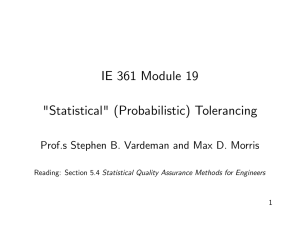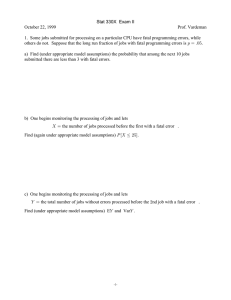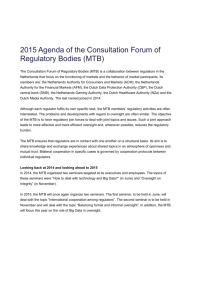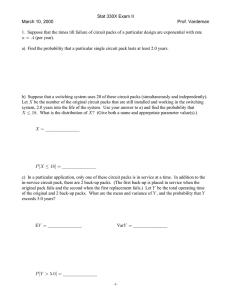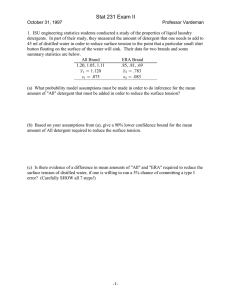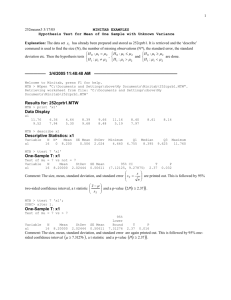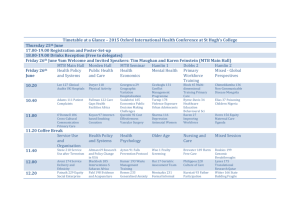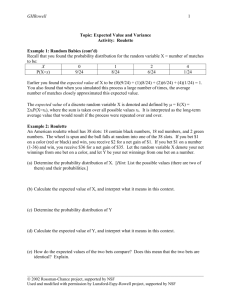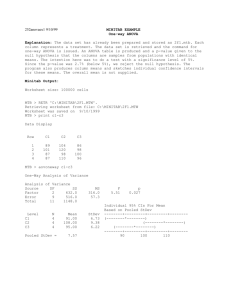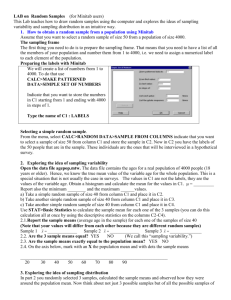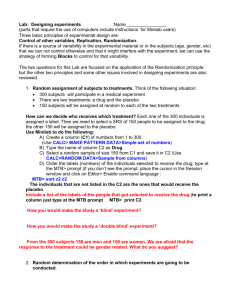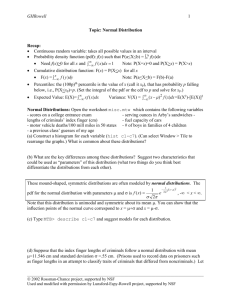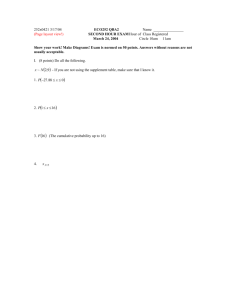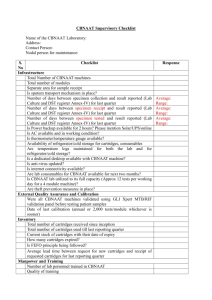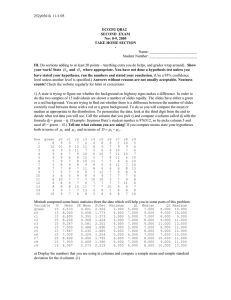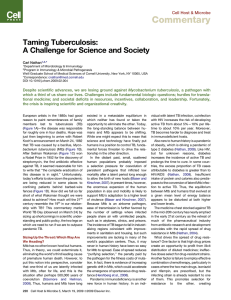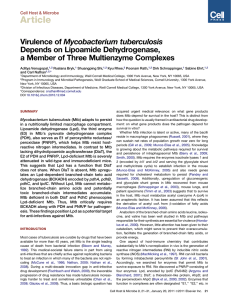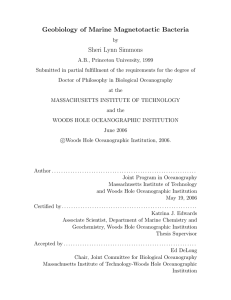“Statistical” (Probabilistic) Tolerancing (Section 5.4 of Vardeman and Jobe) 1
advertisement
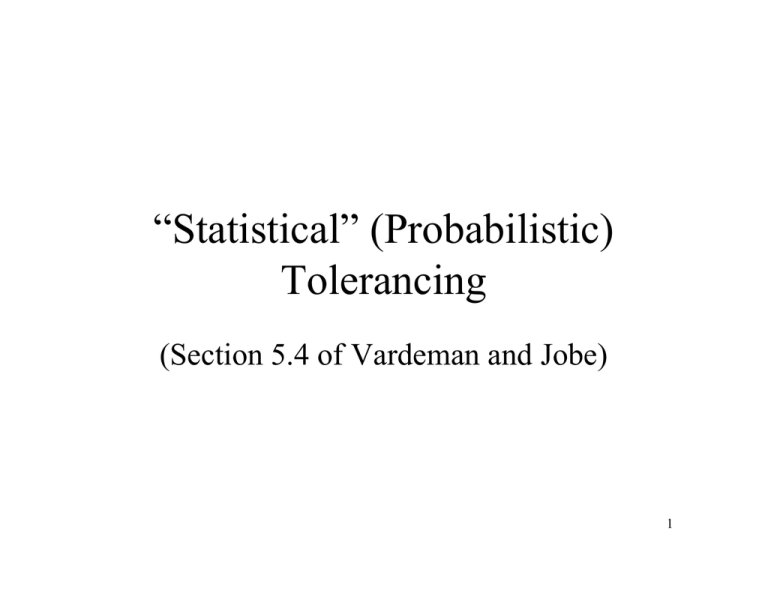
“Statistical” (Probabilistic) Tolerancing (Section 5.4 of Vardeman and Jobe) 1 Piecing Together Information on Variation (to Predict Overall) • Sometimes geometry or physical theory gives me an equation for a variable of interest in terms of other, more basic variables U = g ( X , Y ,..., Z ) • If I have information on how the inputs vary, I can sometimes infer how U varies 2 Car Door Example p = ( − x sin φ , x cos φ ) π π q = p + y cos φ + θ1 − , y sin φ + θ1 − 2 2 s = ( q1 + q2 tan(φ + θ1 + θ2 − π ),0 ) u = ( q1 + ( q2 + d ) tan(φ + θ1 + θ2 − π ), − d ) g1 = w − s1 g 2 = w − u1 Given nominals and “sigmas” for x, y , w, φ ,θ1 and θ 2 what can I say about the the nominals and “sigmas” for the gaps, g1 and g 2 ? 3 Example 5.8 R2 R3 R = R1 + R2 + R3 µ R1 = 100Ω and µ R2 = µ R3 = 200Ω σ R1 = 2Ω and σ R2 = σ R3 = 4Ω What about R? 4 Methods for Studying U (for Independent X,Y,…,Z) • Exact mean and variance for linear g – Equations (5.23) and (5.24) – Helpful for simple tolerance stack-up calculations • Approximations for mean and variance (based on a linearization) for other g – Equations (5.26) and (5.27) – Easily done on something like Mathcad – Variance involves both the input variances AND the derivatives/rates of change 5 VarU and Derivatives 6 Example 5.9 • Nice little tolerance stack-up problem U = Y − X1 − X2 − X 3 − X 4 σ U2 = 12 σ Y2 + ( −1) 2 σ X2 1 + ( −1) 2 σ X2 2 + ( −1) 2 σ X2 3 + ( −1) 2 σ X2 4 • U was head space in a carton designed to hold 4 units of product 7 Mathcad for Example 5.8 R( R1 , R2 , R3) R2. R3 R1 R2 R1 100 σ1 2 R2 200 σ2 4 R3 200 σ3 4 d d R1 R( R1 , R2 , R3) = 1.00 d R( R1 , R2 , R3) = d R2 .25 d .25 d R3 σR σR = R( R1 , R2 , R3) = d d R1 2.449 R3 2 2 R( R1 , R2 , R3) . σ1 d d R2 2 2 R( R1 , R2 , R3) . σ2 d d R3 2 2 R( R1 , R2 , R3) . σ3 8 Simulation … the Easiest Method for Studying U • Any decent statistical package will let you simulate sets of X,Y,…,Z, compute U’s, and then look at descriptive statistics for the simulated values 9 Minitab for Example 5.8 MTB > SUBC> MTB > SUBC> MTB > MTB > Random 1000 c1; Normal 100 2. Random 1000 c2 c3; Normal 200 4. let c4=c1+((c2*c3)/(c2+c3)) Describe c4. Calc>>Random Data>>Normal Calc>>Random Data>>Normal Calc>>Calculator Stat>>Basic Statistics>>Display Basic Descriptive Statistics Variable c4 N 1000 Mean 200.09 Median 200.19 TrMean 200.10 Variable c4 Minimum 192.83 Maximum 207.13 Q1 198.50 Q3 201.69 StDev 2.45 SE Mean 0.08 10 More Mintab for Example 5.8 11 Workshop Door Exercise MTB > SUBC> MTB > SUBC> MTB > SUBC> MTB > SUBC> MTB > SUBC> MTB > MTB > MTB > MTB > MTB > MTB > MTB > MTB > c1=x, c2=y, c3=w, c4=phi c5=theta1, c6=theta2, d=40 (units of cm and radians) Random 1000 c1; Normal 20 .01. Random 1000 c2; Normal 90. .01. Random 1000 c3; Normal 90.4 .01. Random 1000 c4; Normal 0 .001. Random 1000 c5 c6; Normal 1.570796 .001. let c7=-c1*sin(c4) let c8=c1*cos(c4) let c9=c7+c2*cos(c4+(c5-1.570796)) let c10=c8+c2*sin(c4+(c5-1.570796)) let c11=c9+c10*tan(c4+c5+c6-3.141593) let c12=c9+(c10+40)*tan(c4+c5+c6-3.141593) let c13=c3-c11 let c14=c3-c12 12 More Door MTB > Describe 'g1' 'g2'. Descriptive Statistics Variable g1 g2 N 1000 1000 Mean 0.40053 0.40138 Median 0.40035 0.39775 TrMean 0.40040 0.40144 Variable g1 g2 Minimum 0.31109 0.12174 Maximum 0.51216 0.75907 Q1 0.37877 0.34043 Q3 0.42168 0.46280 StDev 0.03078 0.09153 SE Mean 0.00097 0.00289 • What does this analysis show about the gaps? • How could you study the difference in gaps, g1-g2, and/or any relationship between gaps? 13
